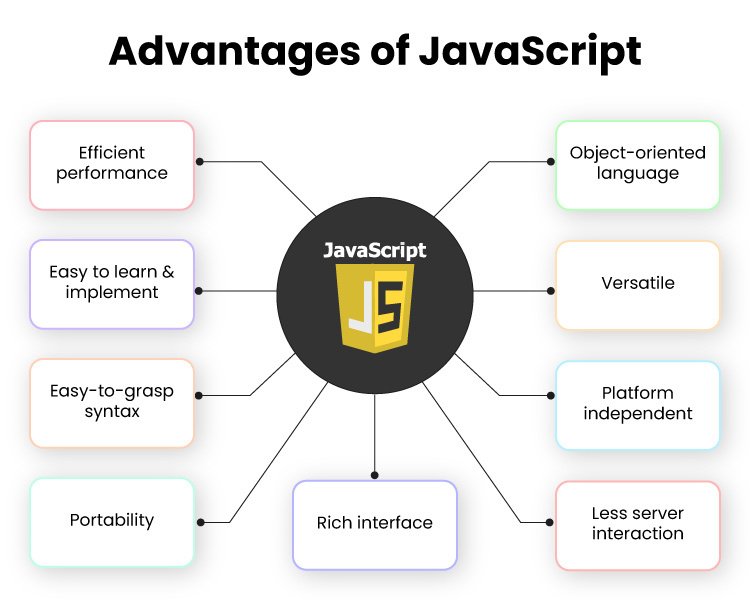
Introduction to JavaScript Benefits
JavaScript has emerged as one of the most influential programming languages in the digital era, transforming from a simple client-side scripting language to a versatile technology that powers modern web development. Originally designed to add interactivity to static web pages, JavaScript has evolved into a robust ecosystem that supports everything from front-end user interfaces to back-end server applications, mobile development, and even Internet of Things (IoT) devices.
Learning JavaScript offers numerous advantages for both aspiring and experienced developers. Its widespread adoption, versatility, and continuous evolution make it an invaluable skill in today’s technology-driven world. As businesses increasingly rely on web and mobile applications, proficiency in JavaScript has become a highly sought-after competency in the job market.
This comprehensive guide explores the key advantages of mastering JavaScript, highlighting why it remains an essential language for developers looking to build cutting-edge digital experiences. Whether you’re a beginner considering which programming language to learn first or an experienced developer looking to expand your skill set, understanding the benefits of JavaScript can help guide your professional development journey.
Versatility and Ubiquity
One of the most significant advantages of learning JavaScript is its remarkable versatility. Unlike many programming languages that are confined to specific platforms or use cases, JavaScript functions seamlessly across various environments. This versatility is primarily due to its universal browser support – JavaScript is the only programming language natively understood by all modern web browsers, making it the de facto language for web development.
JavaScript’s reach extends far beyond the browser. With the advent of Node.js, developers can use JavaScript for server-side programming, enabling full-stack development with a single language. This versatility eliminates the need to switch between different programming languages for front-end and back-end development, streamlining the development process and reducing the learning curve for developers.
The ubiquity of JavaScript is unmatched – it powers approximately 98% of websites on the internet, making it virtually impossible to navigate the modern web without encountering JavaScript-enabled features. From simple interactive elements to complex single-page applications, JavaScript’s presence is pervasive across the digital landscape. This ubiquity ensures that JavaScript skills remain relevant and in demand regardless of specific industry trends or technological shifts.
Learn more about JavaScript’s evolving capabilities in JavaScript 2026: Revolutionizing Web Development.
Abundant Career Opportunities
The job market for JavaScript developers remains exceptionally strong, with consistent demand across various industries. According to industry reports, JavaScript consistently ranks among the most in-demand programming skills, with thousands of job openings available globally at any given time. This demand spans across roles such as front-end developer, full-stack developer, JavaScript engineer, and UI developer.
JavaScript proficiency commands competitive salaries across the industry. The average JavaScript developer salary tends to be higher than many other programming specializations, with experienced developers often commanding six-figure salaries in major tech markets. The financial rewards of JavaScript expertise make it an attractive skill set for career advancement.
The versatility of JavaScript also translates to career flexibility. JavaScript developers can work across diverse sectors including finance, healthcare, e-commerce, entertainment, and technology. This cross-industry applicability provides job security and allows developers to pursue positions aligned with their personal interests and values. Furthermore, JavaScript skills create opportunities for remote work, freelancing, and entrepreneurship, offering lifestyle flexibility that many professionals value.
Enhance your career prospects with professional JavaScript training courses that focus on both fundamentals and advanced concepts.
Powerful Frontend Development
JavaScript excels in creating dynamic and interactive user interfaces that enhance user experience. It enables developers to implement features such as form validation, interactive maps, animated graphics, and responsive design elements that respond to user actions without requiring page reloads. This interactivity is crucial for modern web applications, as users increasingly expect rich, app-like experiences when interacting with websites.
The Document Object Model (DOM) manipulation capabilities of JavaScript give developers precise control over web page elements. This allows for dynamic content updates, style changes, and structural modifications based on user interactions or other triggers. By directly manipulating the DOM, JavaScript creates fluid, responsive interfaces that adapt to user input in real-time.
JavaScript’s asynchronous programming features enable efficient handling of operations that might otherwise block the main thread, such as API calls, file operations, or complex calculations. Promises, async/await syntax, and callback functions allow developers to write code that remains responsive while performing background tasks. This capability is essential for creating smooth user experiences in data-rich applications.
Orbit Training provides comprehensive guidance on leveraging JavaScript for creating exceptional user interfaces and experiences.
Efficient Backend Development
Node.js has revolutionized server-side development by bringing JavaScript to the backend. This runtime environment allows developers to build scalable network applications using the same language they use for client-side development. Node.js’s event-driven, non-blocking I/O model makes it particularly well-suited for data-intensive real-time applications that run across distributed devices.
The ability to use JavaScript throughout the development stack streamlines the development process significantly. Full-stack JavaScript development eliminates context switching between languages, allows for code sharing between client and server, and enables developers to work more efficiently across the entire application. This unification of language across layers reduces development time and cognitive load.
JavaScript’s backend ecosystem includes robust frameworks like Express.js, Koa, and Nest.js that simplify server development by providing structured approaches to routing, middleware implementation, and API creation. These frameworks offer varying levels of abstraction and feature sets, allowing developers to choose the right tool based on project requirements.
The JavaScript backend environment supports efficient database interactions through various libraries and ORMs. Whether working with SQL databases through Sequelize, NoSQL databases like MongoDB through Mongoose, or implementing GraphQL with Apollo, JavaScript provides flexible options for data persistence and retrieval.
Strong Community Support and Resources
JavaScript boasts one of the largest and most active developer communities in the programming world. This extensive community contributes to a wealth of knowledge sharing, problem-solving, and collaborative improvement of the language and its ecosystem. Forums such as Stack Overflow contain millions of JavaScript-related questions and answers, while platforms like GitHub host countless open-source JavaScript projects.
The abundance of learning resources makes JavaScript one of the most accessible programming languages to learn. Comprehensive documentation, interactive tutorials, video courses, and coding bootcamps provide multiple pathways for learning JavaScript at various levels of proficiency. The Mozilla Developer Network (MDN) offers particularly detailed and well-maintained JavaScript documentation that serves as an authoritative reference.
The open-source nature of many JavaScript projects fosters collaboration and knowledge sharing. Developers can examine code from successful applications, contribute to existing projects, and leverage community-built solutions to common problems. This collaborative environment accelerates learning and promotes the adoption of best practices.
Regular community events, including conferences like JSConf and local meetups, provide opportunities for networking, learning from experts, and staying updated on emerging trends and techniques. These events foster a sense of community and provide valuable insights that may not be available through online resources alone.
Rich Ecosystem of Frameworks and Libraries
The JavaScript ecosystem includes powerful frontend frameworks like React, Angular, and Vue.js that streamline the development of complex user interfaces. These frameworks provide structured approaches to building component-based applications, managing state, and optimizing performance. By offering reusable components and efficient rendering strategies, they enable developers to create sophisticated applications with maintainable codebases.
For backend development, frameworks like Express.js provide lightweight, flexible foundations for building web applications and APIs. These frameworks handle common tasks such as routing, middleware integration, and request processing, allowing developers to focus on business logic rather than infrastructure concerns.
JavaScript’s utility libraries such as Lodash, Moment.js, and Axios solve common programming challenges and fill gaps in the language’s native functionality. These libraries provide well-tested, optimized implementations of frequently needed operations, saving development time and reducing potential bugs.
The npm package manager, which hosts over a million packages, makes it easy to discover, install, and manage dependencies. This vast registry of reusable code allows developers to leverage existing solutions rather than reinventing functionality, significantly accelerating development cycles.
Discover how to leverage these powerful tools in our JavaScript courses designed for modern web development needs.
Cross-Platform Mobile Development
JavaScript frameworks like React Native and Ionic enable developers to build native-like mobile applications for multiple platforms using a single codebase. This cross-platform approach significantly reduces development time and maintenance overhead compared to building separate applications for each platform. By allowing code reuse across iOS, Android, and sometimes web platforms, these frameworks offer substantial efficiency gains.
React Native, in particular, has gained widespread adoption for its ability to render native UI components while maintaining a JavaScript-based codebase. This approach delivers near-native performance while preserving the development advantages of JavaScript. Major applications from companies like Facebook, Instagram, and Walmart use React Native, demonstrating its viability for large-scale, commercial applications.
Progressive Web Apps (PWAs), built using JavaScript, HTML, and CSS, provide an alternative approach to mobile development. These web applications offer app-like experiences including offline functionality, push notifications, and home screen installation without requiring users to visit app stores. This approach lowers barriers to user adoption while leveraging web development skills.
Hybrid application frameworks like Cordova and Capacitor wrap JavaScript web applications in native containers, providing access to native device features through JavaScript APIs. This approach allows web developers to create mobile applications with minimal adaptation of their existing skills and codebases.
Future-Proof Language
JavaScript’s ongoing evolution is guided by the ECMAScript standard, which introduces new features and improvements on a regular schedule. Recent versions have added significant enhancements like arrow functions, async/await syntax, class syntax, and modules, keeping the language modern and expressive. This systematic evolution ensures that JavaScript remains relevant and capable of addressing emerging development challenges.
Major technology companies including Google, Microsoft, and Mozilla actively invest in JavaScript’s development and the optimization of JavaScript engines. This institutional support suggests continued long-term relevance and performance improvements for the language. Browser vendors compete to offer the fastest, most compliant JavaScript engines, driving continuous performance enhancements.
JavaScript’s adoption in emerging technology fields demonstrates its adaptability to new computing paradigms. In areas such as machine learning (TensorFlow.js), virtual reality (A-Frame), Internet of Things, and blockchain development, JavaScript is establishing a presence. This expansion into new domains indicates the language’s continuing relevance as technology evolves.
The development of TypeScript, a strongly-typed superset of JavaScript, addresses some of the language’s historical weaknesses while maintaining compatibility with the JavaScript ecosystem. This evolution path provides developers with options for greater type safety and tooling support without abandoning the core language.
Explore the future of JavaScript in our article on JavaScript 2026: Revolutionizing Web Development.
Enhanced Developer Productivity
JavaScript’s interpreted nature eliminates compilation steps during development, allowing for immediate feedback through browser developer tools. This quick feedback loop accelerates the development process by enabling rapid testing and iteration. The ability to instantly see the results of code changes fosters experimentation and facilitates debugging.
Modern JavaScript development environments offer sophisticated tooling that enhances productivity. Features like intelligent code completion, automated testing frameworks, hot module replacement during development, and powerful debugging capabilities streamline the development workflow. Tools such as ESLint enforce coding standards and catch potential issues before runtime.
JavaScript’s asynchronous nature enables efficient handling of I/O operations without blocking the main thread. This event-driven programming model is particularly well-suited for web applications that need to remain responsive while performing background tasks like data fetching or processing. The Promise API and async/await syntax make asynchronous code easier to write and maintain.
The rise of static site generators, JAMstack architecture, and serverless computing—all frequently implemented with JavaScript—provides efficient approaches to building high-performance websites and applications. These methodologies leverage JavaScript’s strengths while addressing historical performance concerns, resulting in fast, scalable applications with simplified deployment models.
Orbit Training offers professional development courses that emphasize productivity-enhancing JavaScript techniques and best practices.
Conclusion
Learning JavaScript offers unparalleled advantages in today’s technology landscape. Its versatility enables development across the entire web stack, from interactive frontend interfaces to robust backend systems and even mobile applications. This cross-platform capability makes JavaScript a uniquely valuable skill that provides exceptional return on investment for time spent learning.
The career opportunities available to JavaScript developers remain abundant and diverse. With strong demand across industries and competitive compensation, JavaScript proficiency opens doors to numerous professional paths. Whether pursuing frontend specialization, full-stack development, or mobile application creation, JavaScript skills form a solid foundation for a rewarding technology career.
JavaScript’s vibrant ecosystem and community support ensure that developers have access to high-quality resources, tools, and assistance throughout their learning journey. The availability of comprehensive frameworks, extensive libraries, and dedicated communities accelerates development and promotes best practices. This ecosystem continues to evolve, with exciting developments like AI-enhanced features on the horizon, as discussed in our article on JavaScript 2026.
For those considering which programming language to invest their time in, JavaScript presents a compelling case. Its widespread adoption ensures long-term relevance, while its evolving nature keeps it at the forefront of web development. The language’s accessibility to beginners, combined with its capacity for advanced application development, makes it appropriate for developers at all experience levels.
To fully leverage the advantages of JavaScript, structured learning through professional courses is highly beneficial. Comprehensive JavaScript training provides the guidance, practice, and feedback necessary to develop proficiency efficiently. By investing in quality education and consistent practice, aspiring developers can harness JavaScript’s full potential and position themselves for success in the dynamic field of web development.




